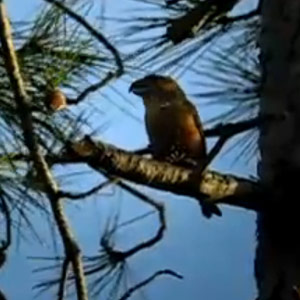Pratique | Identification
Distinguer le Bec-croisé perroquet du Bec-croisé des sapins

Profil typique du Bec-croisé perroquet (Loxia pytyopsittacus), Schoorl (Pays-Bas), janvier 2008.Source : image extraite d’une vidéo postée par SanderTerlouw sur Youtube
Introduction
Le Bec-croisé perroquet (Loxia pytyopsittacus) est une espèce peu connue des observateurs francophones, notamment parce qu’elle est difficile à distinguer avec certitude du Bec-croisé des sapins (Loxia curvirostra): une analyse attentive du chant et de la structure de l’oiseau est nécessaire, ce qui suppose de bonnes conditions d’observation. Les comités d’homologation nationaux sont ainsi d’une extrême prudence avant de valider une donnée: celui de Belgique exige que « l’observation soit faite de dessus (et non pas en contrebas), accompagnée d’une photo et d’un sonogramme » (graphique représentant la fréquence du son en fonction du temps).
Pourtant, l’oiseau atteint parfois l’Europe de l’Ouest lors d’invasions, comme cela fut le cas à la fin du mois d’octobre 2007 au Danemark: des groupes d’une dizaine d’oiseaux furent ensuite vus aux Pays-Bas jusqu’au mois de janvier 2008 au moins. Suite à l’invasion de 2003, le Bec-croisé perroquet a même niché aux Pays-Bas!
Marc Fasol, un observateur belge, a eu la chance d’observer l’espèce en janvier 2008, et il nous transmis des photos: nous en profitons pour vous présenter les critères d’identification permettant de le distinguer du Bec-croisé des sapins.
Abstract
Identifying Parrot Crossbills Loxia pytyopsittacus from Common Crossbills L. curvirostra is not always easy. Indeed, there’s a variation in bill shape of Common Crossbill, some of them having fine and pointed bills with the bill-tips well overlapping, while others have a much deeper and heavier bill (such as Eastern and Mediterranean subspecies) and are thus much more similar to Parrot Crossbill. On his website, Dick Forsman, a famous Finnish birder, speaks about two types of Common Crossbill: the « Spruce Crossbill » and the « Pine Crossbill », the latter being heavier billed.
The Parrot Crossbill is moreover a really big-headed bird, and the birder has to look at the bird as a whole in order to assess the proportional size of the head. The vocalizations is another important feature. The Parrot Crossbill is also often more confident.
A few dozens of birds were watched from October 2007 to January 2008 in the Nederlands, and Marc Fasol, from Belgium, took some photos. This article presents you the features to tell apart the Parrot Crossbill and the Common Crossbill.
Poursuivez la lecture de cet article, en vous abonnant dès maintenant !
Découvrez les Archives d’Ornithomedia.com
Pour seulement 10,00 €TTC/an (ou 6,00 € les 6 mois)
Profitez de plusieurs centaines d’articles en accès illimité et sans aucun engagement.
Compléments
À lire aussi sur Ornithomedia.com
- Importants mouvements de Becs-croisés bifasciés dans le nord de l’Europe depuis juin 2013
- Une discussion sur une photo de bec-croisé sur notre forum Identification
Dans la boutique d’Ornithomedia.com
Ouvrages recommandés
- Le Guide Ornitho de L. Svensson et al
- The Sound Approach to birding, a guide to understanding bird sound de Mark Constantine et The Sound Approach





Aucun commentaire sur ce sujet
Participer à la discussion !